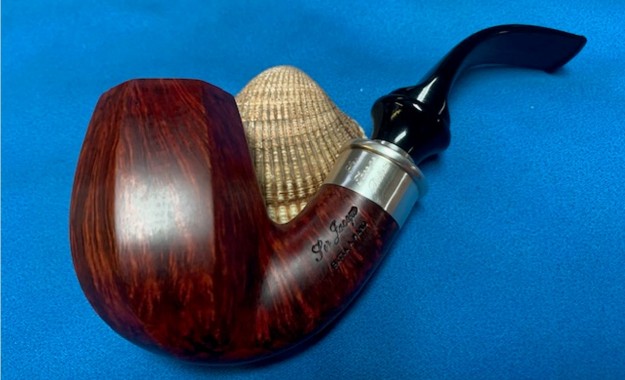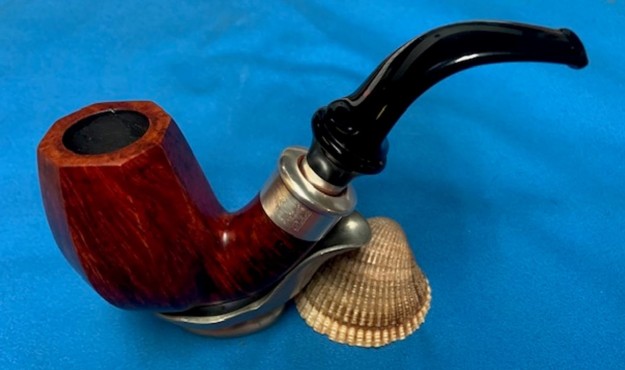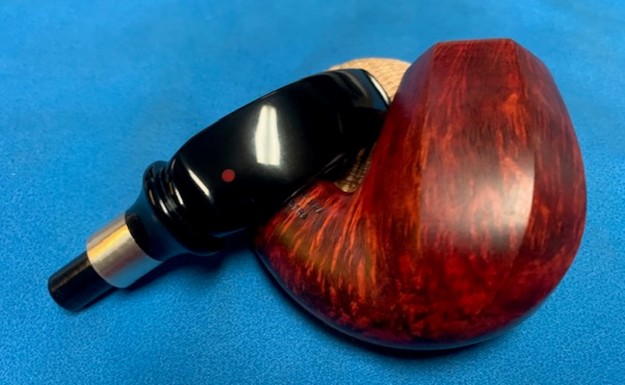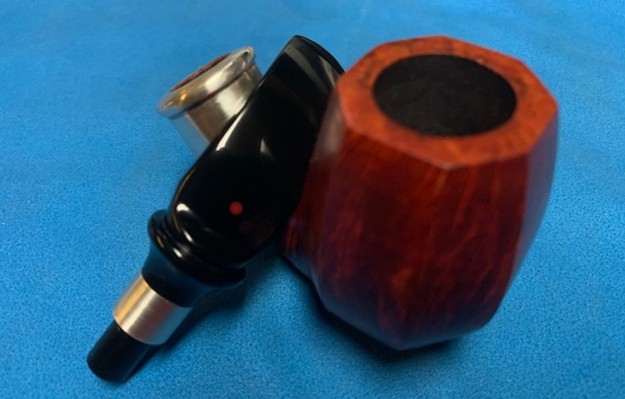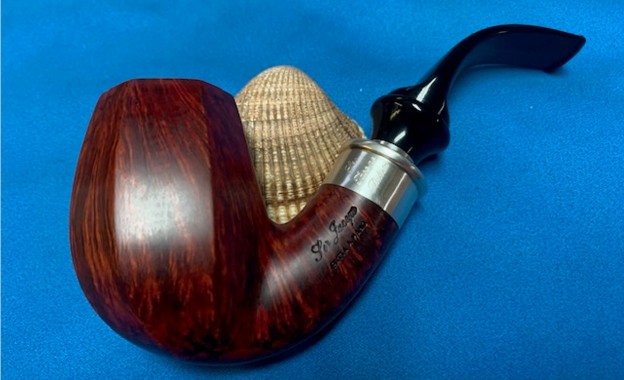Blog by Steve Laug
 A few weeks ago I was contacted from a fellow in Montana who was selling his pipes as they had not been used for quite a few years. I asked him for a picture and he sent me the one to the left. It included the following brands (from the top to the bottom of the photo): Savinelli Autograph 5 Freehand, Mastro de Paja Ciocco 0C Bulldog, Mastro de Paja Media 1B Bent Billiard, Ser Jacopo Delecta Octagonal Bent Billiard, Caminetto Business KS 118 Canadian, Radici Rind Rhodesian, Dunhill Bruyere ODA 836 Panel Billiard, Barontini Straight Grain B3 Freehand and a Ben Wade Martinique Hand Made in Denmark Freehand.
A few weeks ago I was contacted from a fellow in Montana who was selling his pipes as they had not been used for quite a few years. I asked him for a picture and he sent me the one to the left. It included the following brands (from the top to the bottom of the photo): Savinelli Autograph 5 Freehand, Mastro de Paja Ciocco 0C Bulldog, Mastro de Paja Media 1B Bent Billiard, Ser Jacopo Delecta Octagonal Bent Billiard, Caminetto Business KS 118 Canadian, Radici Rind Rhodesian, Dunhill Bruyere ODA 836 Panel Billiard, Barontini Straight Grain B3 Freehand and a Ben Wade Martinique Hand Made in Denmark Freehand.
Almost all of them were higher end pipes and all were hand made pipes. They were a mix of finishes – smooth, sandblast and also rusticated. They were a mix of shapes as well and the majority of them were Italian Made other than the Dunhill and the Ben Wade Martinique. They were beautiful pipes and after exchanging quite a few photos of the pipes from various angles to get a sense of what was there we struck a deal. We sent him the payment and the pipes arrived in Idaho a few days after I left for Vancouver.
Jeff cleaned them all and this week I received them in Vancouver. I am impressed with the way they cleaned up and the beauty of the brands. They truly are some beautiful pipes. I just need to put the final touches on each of them and address minor issues on the bowl rims and the stems and they should be good to go. I am really looking forward to working on each of them in the days ahead.
This evening after work I decided to continue working on the lot. I chose to work on the smooth octagonal bent Billiard with a silver ferrule and tip on the stem. It has a classic Large Bent Octagonal Billiard shape with an Italian twist. The is smooth and well shaped. There is a silver ferrule round the shank end as well as a silver band around the tenon end of the stem. The pipe is stamped on three sides of the shank. On the left side it Ser Jacopo [over] Fatta A Mano (made by hand). On the underside of the shank it is stamped Delecta. The stamping on the right side of the shank it read Per Aspera [over] Ad Astra. The silver ferrule is stamped on the top left side and reads Ser [over] Jacopo [over] Delecta. On the underside it is stamped 925 in an oval as the silver quality designation. There is a coral dot logo is on top side of the stem. The stamping is clear and readable. The reddish stained finish was very dirty with grime ground into the smooth briar. The bowl had a moderate cake and the rim top/inner edge had some lava flowing up from the bowl. The inner edge of the bowl was covered with some lava so it was hard to know its condition with certainty. The stem is black acrylic fancy saddle stem and was dirty with tooth marks and chatter on both sides ahead of the button. The silver ferrule and tenon end were oxidized and dirty. Jeff took photos of the pipe before he started his clean up work on it.
 Jeff took photos of the bowl and rim top to show what they looked like before the clean up. You can see the cake in the bowl overflowing on the inner edge rim top. He also took some photos of the stem to show the condition of both sides. You can see the tooth marks and chatter on the top and underside next to the button.
Jeff took photos of the bowl and rim top to show what they looked like before the clean up. You can see the cake in the bowl overflowing on the inner edge rim top. He also took some photos of the stem to show the condition of both sides. You can see the tooth marks and chatter on the top and underside next to the button.

 The photos of the sides and heel of the bowl show the grain around the bowl and shank. The stain adds depth finish on the pipe. Even under the grime it is a real beauty.
The photos of the sides and heel of the bowl show the grain around the bowl and shank. The stain adds depth finish on the pipe. Even under the grime it is a real beauty.
 The stamping on the sides of the shank and on the silver ferrule is shown in the photos below. It is clear and readable as noted above.
The stamping on the sides of the shank and on the silver ferrule is shown in the photos below. It is clear and readable as noted above.

 I turned to Pipephil (http://pipephil.eu/logos/en/logo-s5.html) to remind myself of the background of the brand. I also wanted to see what the single Coral dot meant on the stem. I knew that the Coral dot was on the older pipes but that was all I knew. I include a screen capture of the section on the brand below. The third photo below shows a similar Coral dot on the stem.
I turned to Pipephil (http://pipephil.eu/logos/en/logo-s5.html) to remind myself of the background of the brand. I also wanted to see what the single Coral dot meant on the stem. I knew that the Coral dot was on the older pipes but that was all I knew. I include a screen capture of the section on the brand below. The third photo below shows a similar Coral dot on the stem.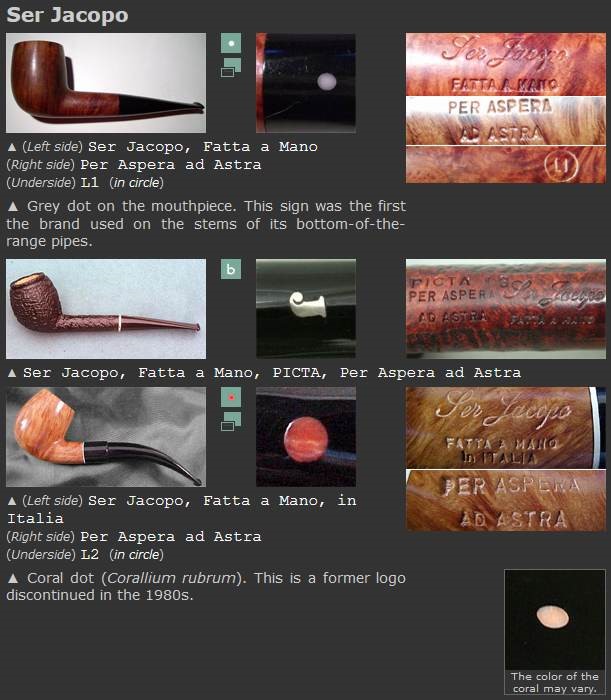 I am also including the information that I found there in the sidebar on PipePhil. I quote that below. I have highlighted the R2 designation below in red.
I am also including the information that I found there in the sidebar on PipePhil. I quote that below. I have highlighted the R2 designation below in red.
Founder of the brand in 1982: Giancarlo Guidi (1943 – †2012). Production (2006): ~ 6000 pipes/year. Ser Jacopo seconds: Gepetto.
Finish mark: Rusticated pipes: R1 (dark brown) R2 (light brown); Sandblasted pipes: S (black), S1 (dark brown), S2 (light brown), S3 (tanshell); Smooth pipes: L (red), L1 (acceptable grain), L2 (nice grain), L3 (exceptional grain).
I then turned to Pipedia (https://pipedia.org/wiki/Ser_Jacopo) to read some more about the brand and see if there were more details regarding the single Coral dot. I quote below.
Ser Jacopo (provided by Marble Arch Ltd., US importer and distributor of Ser Jacopo)
Smokingpipes.com has an excellent concise history available on their website Ser Jacopo History at Smoking Pipes.com
Ser Jacopo, better to say Ser Jacopo dalla Gemma, was started by Giancarlo Guidi in 1982 upon leaving Mastro de Paja.
Giancarlo Guidi and Bruto Sordini broke away from Mastro de Paja in 1981 in pursuit of their own company. Ser Jacopo was named after an Italian nobleman. Guidi and Sordini, having taken part in creating the now infamous Pesaro “school” of pipe making, wanted to expand further. To accomplish this, Ser Jacopo focused their efforts on the pairing of the briar with a seemingly endless variety of mounts. Through the use of precious metals and stones, horn, and exotic woods Ser Jacopo pipes are given unique characters that many collectors find quite aesthetically pleasing. Although Ser Jacopo pipes borrow heavily from classical shapes, they are indeed quite unique in style.
In addition to creative mountings, Ser Jacopo is also well known for making themed pipes, and the most famous of these themes is perhaps the Picta Series, where pipes are modeled after pipes seen in pictures by and of famous artists, such as Vincent Van Gough.
Ser Jacopo makes multiple grades of pipes, with the “entry” level being the Geppetto brand, and the highest grade being the “Gem” series.
The small Ser Jacopo shop produces approximately 6000 pipes per year. The pipes are known for using outstanding Italian briar, which is well seasoned. The pipes have earned a well-deserved reputation for having excellent smoking qualities, equal or better than any other fine Italian pipe maker (or, for that matter, any other pipe maker in the world).
Giancarlo Guidi passed away on August 6, 2012, leaving behind a great legacy. He was 64 years old.
Nomenclature – the section on the nomenclature helps understand the stamping on the sides of the shank. It is helpful and really quite interesting.
The standard nomenclature found on Ser Jacopo pipes is as follows:
Ser Jacopo Fatta A Mano In Italia Per Aspera Ad Astra – Fatta A Mano translates to “Made By Hand”. Per Aspera Ad Astra is a Latin phrase found on Ser Jacopo pipes and is the Ser Jacopo motto. It translates to “To the Stars Through Travails”, meaning that success comes through hard work. In the Summer 1997 Pipes and Tobaccos article Giancarlo Guidi translated this as “through a difficult way until the stars are reached”.
Ser Jacopo Pipes are generally found in one of three finishes (rusticated, sandblast, smooth) designated by a letter and number code:
R1: Rusticated, dark brown or plum finish.
R2: Rusticated, light brown finish.
S: Sandblast, black
S1: Sandblast, dark brown
S2: Sandblast, light brown
S3: Sandblast, tanshell
L: Smooth, red, usually with silver trim
L1: Smooth, flame grain, various finishes
L2: Smooth, straight grain, various finishes
L3: Smooth, straight grain extra, discontinued
Dating Pipes
 In the photo to the left you can see the development of the stem inserts on the pipes.
In the photo to the left you can see the development of the stem inserts on the pipes.
Top: Early Red Coral Logo Middle: Coral Logo with Silver Ring Bottom: Modern Day Silver J Logo – Courtesy of Mike Ahmadi
Ser Jacopo pipes is somewhat difficult, because Ser Jacopo does not generally use date codes (the exception being the Diamond Gemma series pipes, which are dated coded). Early pipes (from 1983 to 1997) featured a red coral dot on the mouthpiece, sometimes found encircled in a silver ring. This was discontinued and changed to a sterling silver letter “J”. On the Gemma series of pipes, the mouthpiece logo is a precious stone surrounded by an 18k gold ring.
The pipe I am working on is one of the early pipes (1983-1997) with a coral dot in the top of the saddle stem. It is a lovely pipe with an L Red finish and silver trim. Now it is time to work on the pipe and bring it back to life.
Armed with that information I turned to work on the pipe itself. Before he sent it to me, Jeff had done an amazing job cleaning the pipe. It almost looked like a different pipe after his work. He reamed the pipe with a PipNet pipe reamer and removed the rest of the cake with a Savinelli Fitsall Pipe Knife. He scrubbed the bowl with undiluted Murphy’s Oil Soap and a tooth brush. He rinsed it under running warm water to remove the soap and grime. The finish looked very good and the rugged finish felt good in the hand. He cleaned out the inside of the shank and the airway in the stem with isopropyl alcohol, cotton swabs and pipe cleaners. He soaked the stem in Briarville’s Pipe Stem Deoxidizer and then rinsed it off with warm water. He scrubbed the stem with Soft Scrub and a tooth brush and rinsed it off with warm water. It looked good when I took it out of the package of pipes he shipped me. There were some shiny spots on the finish where the shellac coat had not all come off. It would need to be removed to even it out. I took photos of the pipe before I started my part of the restoration work. 
 I took close up photos of both the rim top and the stem. Jeff had been able to get the grime and lava off of the rim top and it looked very clean. You can see the spotty shellac coat that still remains on the bowl and rim top. The stem looked very clean. The tooth marks and chatter were much less than on the previous pipes in this collection and they were predominantly near the button. They should be easy to remove.
I took close up photos of both the rim top and the stem. Jeff had been able to get the grime and lava off of the rim top and it looked very clean. You can see the spotty shellac coat that still remains on the bowl and rim top. The stem looked very clean. The tooth marks and chatter were much less than on the previous pipes in this collection and they were predominantly near the button. They should be easy to remove.  The stamping on the sides of the shank was readable as noted above. I took photos of the stamping on each side to show the condition and readability. I also took a photo of the pipe with the stem removed to give an idea of the perspective and design of the pipe.
The stamping on the sides of the shank was readable as noted above. I took photos of the stamping on each side to show the condition and readability. I also took a photo of the pipe with the stem removed to give an idea of the perspective and design of the pipe.
 To deal with the spotty coat of shellac on the bowl and shank I used a cotton pad and alcohol to wipe down the briar. I was able to remove the shellac coat completely and the grain really showed through. Here is what it looks like at this point in the process.
To deal with the spotty coat of shellac on the bowl and shank I used a cotton pad and alcohol to wipe down the briar. I was able to remove the shellac coat completely and the grain really showed through. Here is what it looks like at this point in the process. 
 I polished the smooth bowl and rim top with micromesh sanding pads using 1500-12000 grit sanding pads and wiping it down after each sanding pad with a damp cloth to remove the sanding dust and debris.
I polished the smooth bowl and rim top with micromesh sanding pads using 1500-12000 grit sanding pads and wiping it down after each sanding pad with a damp cloth to remove the sanding dust and debris.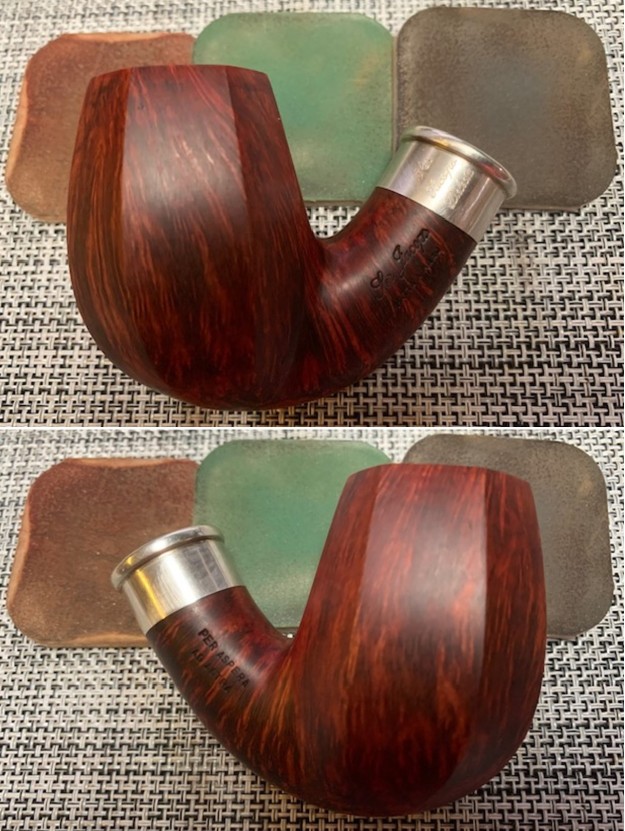




 I worked some Before & After Restoration Balm into the finish of the bowl and shank with my fingers. I want the product to go deep into the finish because it works to clean, enliven and protect the briar. Once I was confident that it was deeply worked into the finish I wiped it off and buffed it with a soft cloth to polish it. The pipe really began to have a rich shine. I took some photos of the bowl at this point to mark the progress in the restoration. The grain really stands out on the pipe in the photos below.
I worked some Before & After Restoration Balm into the finish of the bowl and shank with my fingers. I want the product to go deep into the finish because it works to clean, enliven and protect the briar. Once I was confident that it was deeply worked into the finish I wiped it off and buffed it with a soft cloth to polish it. The pipe really began to have a rich shine. I took some photos of the bowl at this point to mark the progress in the restoration. The grain really stands out on the pipe in the photos below.

 I set the bowl aside and turned to work on the stem. I sanded out the tooth marks in the acrylic surface of the stem with 220 grit sandpaper and started the polishing with a folded piece of 600 grit wet dry sandpaper.
I set the bowl aside and turned to work on the stem. I sanded out the tooth marks in the acrylic surface of the stem with 220 grit sandpaper and started the polishing with a folded piece of 600 grit wet dry sandpaper. I polished the vulcanite stem with micromesh sanding pads – wet sanding it with 1500-12000 grit pads. I wiped it down with Obsidian Oil after each sanding pad.
I polished the vulcanite stem with micromesh sanding pads – wet sanding it with 1500-12000 grit pads. I wiped it down with Obsidian Oil after each sanding pad.
 I polished it with Before & After Pipe Polish – both the Fine and Extra Fine polishes. I gave it a final coat of oil and set it aside to dry.
I polished it with Before & After Pipe Polish – both the Fine and Extra Fine polishes. I gave it a final coat of oil and set it aside to dry.  This Ser Jacopo Delecta Octagonal Bent Billiard with Silver Ferrule and an acrylic saddle stem is a great looking pipe now that it has been restored. The beautiful finish really highlights the grain and the polished finish is stunning. The Silver Ferrule and Silver tenon space is also a great addition. I put the stem back on the bowl and carefully buffed the pipe with Blue Diamond on the buffing wheel. I gave the bowl and the stem multiple coats of carnauba wax on the buffing wheel and followed that by buffing the entire pipe with a clean buffing pad. I hand buffed the pipe with a microfiber cloth to deepen the shine. The finished Ser Jacopo Delecta Octagonal Bent Billiard fits nicely in the hand and feels great. Give the finished pipe a look in the photos below. The dimensions of the pipe are Length: 5 ½ inches, Height: 2 ½ inches, Outside diameter of the bowl: 1 ¼ inches, Chamber diameter: ¾ of an inch. The weight of the pipe is 87 grams /3.03 ounces. I will be adding the pipe to the Italian Pipe Makers Section of the rebornpipes store. If you are interested in purchasing this pipe send me a message or an email. Thanks for reading this blog and my reflections on the pipe while I worked on it.
This Ser Jacopo Delecta Octagonal Bent Billiard with Silver Ferrule and an acrylic saddle stem is a great looking pipe now that it has been restored. The beautiful finish really highlights the grain and the polished finish is stunning. The Silver Ferrule and Silver tenon space is also a great addition. I put the stem back on the bowl and carefully buffed the pipe with Blue Diamond on the buffing wheel. I gave the bowl and the stem multiple coats of carnauba wax on the buffing wheel and followed that by buffing the entire pipe with a clean buffing pad. I hand buffed the pipe with a microfiber cloth to deepen the shine. The finished Ser Jacopo Delecta Octagonal Bent Billiard fits nicely in the hand and feels great. Give the finished pipe a look in the photos below. The dimensions of the pipe are Length: 5 ½ inches, Height: 2 ½ inches, Outside diameter of the bowl: 1 ¼ inches, Chamber diameter: ¾ of an inch. The weight of the pipe is 87 grams /3.03 ounces. I will be adding the pipe to the Italian Pipe Makers Section of the rebornpipes store. If you are interested in purchasing this pipe send me a message or an email. Thanks for reading this blog and my reflections on the pipe while I worked on it.
As always, I encourage your questions and comments as you read the blog. Thanks to each of you who are reading this blog. Remember we are not pipe owners; we are pipe men and women who hold our pipes in trust until they pass on into the trust of those who follow us.